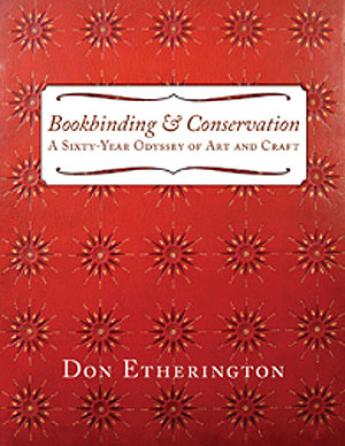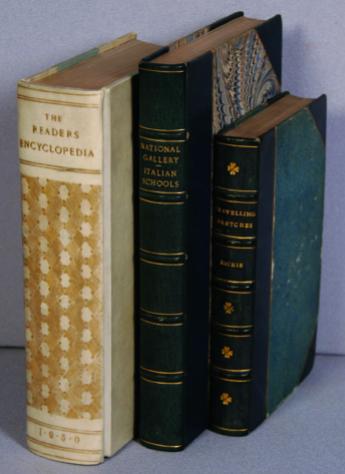Antiquarian Booksellers' Association of America Oak Knoll Books
Bookbinding & Conservation: A Sixty-Year Odyssey of Art and Craft, by Don Etherington

A New Publication of Oak Knoll Press
Don Etherington’s autobiography takes the reader through his lifelong journey of bookbinding and conservation. He began bookbinding at the age of thirteen as a student at the Central School of Arts and Crafts and later went on to study bookbinding and design at the London School of Printing. Since then, he has held positions at the Biblioteca Nazionale in Florence, The Library of Congress, the Harry Ransom Humanities Research Center at the University of Texas at Austin, and Information Conservation, Inc. In 1982, he co-authored with Matt Roberts Bookbinding and the Conservation of Books: A Dictionary of Descriptive Terminology, the first comprehensive attempt to compile terminology from all the bookmaking and conservation fields. His works can be found in collections worldwide.
Etherington's memoirs contain numerous personal photographs that richly illustrate his story. The autobiography is followed by a pictorial catalogue of many of his fine bindings.
Bookbinding and Conservation by Don Etherington is a unique account of the personal and professional life of this important figure in the world of book binding and conservation: an excellent pick for anyone interested in bookbinding and the lives of major bookbinders.
Read how Don Etherington first developed his skills, and how he was instructed by George Frewin, who had worked for Sangorski & Sutcliffe:
In preparation for my interviews at the Central School the three crafts I felt would interesting to pursue were jewelry, engraving, and bookbinding. These courses lasted for three years and combined academic classes with the craft sessions. Bookbinding was actually my preferred choice at that time, though I have never really discovered why. In preparing a small portfolio of work for these interviews I had designed a complete alphabet of floriated capitals in color, a connection I imagine to those early classes of Miss Blades in copperplate handwriting. I was excited at being given this chance to interview at the Central School and I felt very sure that I wanted to pursue a career in which I could use my hands in a creative way. I interviewed at all three departments with the head instructors, and fortunately I was accepted for one of the six places available in bookbinding. The academic classes were held in a schoolhouse near Covent Garden, one or two miles from the Central. This entailed a lot of running between the two facilities when attending both academic and craft classes on the same day.
To gain furthers skills I also attended evening classes at the Central with instructors other than the daytime teachers. My instructor in the daytime was George Frewin, who had worked as a coverer for Sangorski and Sutcliffe, one of London’s finest binderies. He is pictured in the third row behind Stanley Bray, who is holding the firm’s cat. Also teaching at Central was Fred Wood, a wonderful craftsman.
Our class of six was very fortunate in having these two teachers, though in the beginning we had no idea how fortunate we really were. The evening teachers included Mr. Parks and the renowned binder William Matthews, who was Deborah Evetts’ teacher. Deborah Evetts became a very well known bookbinder and conservator and worked for many years at the Pierpont Morgan Library in New York. Only a couple of us from the day class also attended evening sessions, and I believe I was the only one of my day session classmates to enter the craft of bookbinding and continue working in that field as a career. At the same time I was at the Central School another student named Bryan Maggs was studying with William Matthews and became a very good binder in his own right. His family owned Maggs Brothers, one of the most famous rare bookshops in London. Bryan was for many years the chief librarian at the Paul Getty Collection, housed in a castle-like building near Oxford. This amazing collection includes a significant number of bindings of T.J. Cobden-Sanderson, and it is where I discovered his use of the concertina guard on his bindings.
The day classes under Ferwin and Wood were very important to me in those formative years. Their emphasis on quality work and patience was planted deeply within me. One aspect of their teaching that has stayed with me all these years is the minute accuracy that was demanded in all the steps we perform in bookbinding. For example, when placing the book in the laying press prior to trimming the edges with the plough,
I always had to have one of the instructors check to see if the book was exactly parallel to the checks of the laying press. Often I would have to take the book out not once but a number of times to achieve perfection. Having to satisfy them certainly tested one’s patience. This exactness was required of every operation. At times it drove all of us crazy, but I know now that these were important lessons to learn, particularly at the age of thirteen and especially at the beginning of a career in bookbinding. Amazingly, after only the first few weeks of classes I was completely enamored with the craft, and I have never over the course of more than half a century been bored by or tired of the work. I believe to this day that my work still reflects their standards. The debt I owe them is great and their spirit is passed on to all of the students I have taught utilizing those very same principles.
The pictures show: Sangorski and Sutcliffe staff, June 3, 1947, Stanley Bray is seated in the center holding the bindery cat, and George Frewin is in the third row behind Stanley. Don Etherington’s early bindings executed at The Central School when he was fourteen.
Don Etherington: Bookbinding & Conservation: A Sixty-Year Odyssey of Art and Craft
Foreword by Bernard Middleton. New Castle, Delaware: Oak Knoll Press 2010. 180 pages. Hardcover. Dust jacket. ISBN 9781584562771
>>> Oak Knoll Press
The excerpt was published in The Oak Knoll Biblio-Blog (January 13, 2011), and it is presented here by permission of Bob Fleck and Oak Knoll Press. Thank you very much.


